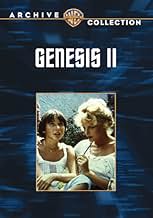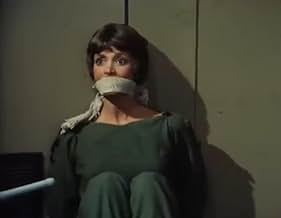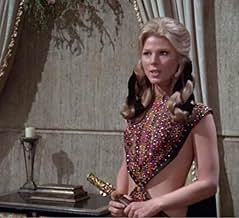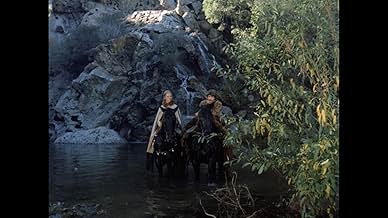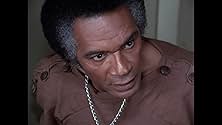IMDb RATING
5.8/10
1.2K
YOUR RATING
A scientist who has been preserved in suspended animation wakes up to find himself in a primitive society in the future.A scientist who has been preserved in suspended animation wakes up to find himself in a primitive society in the future.A scientist who has been preserved in suspended animation wakes up to find himself in a primitive society in the future.
- Awards
- 1 nomination total
- Director
- Writer
- All cast & crew
- Production, box office & more at IMDbPro
Storyline
Did you know
- TriviaThe science fiction justification for Lyra-a (Mariette Hartley) and other Tyranians having two navels is that they have redundant circulatory systems. However, Gene Roddenberry joked that the behind-the-scenes reason was to make up for the covered navels mandated by network and studio censors during the production of Star Trek (1966).
- GoofsWhen Dylan Hunt is first shown being discovered after the earthquake, his right leg is hanging off of the table he is strapped to. When the camera angle switches to the inside the chamber, both legs are now on the table.
- ConnectionsFollowed by Planet Earth (1974)
Featured review
This film was made for television by Gene Roddenberry, under his NBC contract to develop new properties. Its provocative title referred to a new ecological beginning for Earth, after WWIII had been fought, 150-plus years had gone by, and the ravages of nuclear bombs had been all-but-obliterated. The series was turned down by network 'tsars', although scripts for it were authorized. Two more versions of the concept, including "Planet Earth" were produced as 'pilot' films for a series also. The storyline opens in the near future with Dylan Hunt working at a huge underground facility in Carlsbad Caverns. His project is served by magnetic-slide underground tunnels through which run high-speed trains. His subject is cryogenics, which is a technology with many potential uses from freezing men against the time their diseases will be cured to space-travel applications. Once he arrives on a sub-shuttle train back at the Project, he tries to help as something tectonic goes wrong; he is trapped in a life-sustaining cryogenic environment and sleeps for a century and a half. Those who eventually awaken him are people from the city of Pax, whose teams are combing the Earth contacting and influencing civilizations everywhere. She who finds him first is Lyra-A, a gorgeous mutant from the totalitarian city of Tyrania, set in the mountains near Phoenix; we learn later she is only pretending to be an escapee but really spying, learning what Pax's leaders are planning. Once fully restored, after her nursing and indoctrination of him(quite against Pax's leaders' policies), he sees classrooms and other rebuilding activities, and he meets the city's leaders, the Primuses; and of course they want him to join their effort. They are against the use of nuclear power, against killing for that matter; as a scientist, their attitude does not persuade him to adopt their radical solution to Earth's problems. Feeling he is only hearing one side of the story, he runs off with Lyra-A to see Tyrania. The problem with the mutant city, the abject fear and worship shown to her from the beginning by folk near a train departure station and once within the City, is disturbing to his assumptions. He finds out why the folk were afraid very soon. The city's leaders want him also, to help them repair the defective nuclear power station supplying their city. And they are willing to use the "stim"--an electronic pleasure-pain rod--a Roddenberry hangup-type device--that is the lineal descendant of the agonizer pain device used in the "Star Trek" episodes "Mirror, Mirror" and "Spocks' Brain" plus certain alien race Klingons' devices from the same TV series. Lyra-A begs him to join them; she loves him. But he must refuse and is sentenced to slavery, in the hopes he can be broken. The Pax Team he met earlier, three operatives, rescue him, and get him out of the infernal mutants' city. He goes off alone and, for his own reasons, blows up the nuclear plant. Then he returns to Pax, being willing to help them rebuild the world--to give it "Genesis II". The script for the project was written by Gene Roddenberry; the direction was well-done by John Llewellyn Moxey. Robert M. Anderson did the art direction, William Ware Theiss the costumes. "Star trek" veteran Gerald Perry Finnerman was its cinematographer. This is a beautiful production, using UC Riverside settings to augment its low budget; and its sub-shuttle trains are an excellent device by my standards--the magnetic equivalent of the "Star Trek" starship's less- believable transporter molecular disassembly machines. The mutants with their two navels are well done; the costumes, sets and exterior landscape shots are far-above-average for any film. Alex Cord lacks the classical speech to play the scientist Dylan Hunt, but he is attractive and manages to put the part across. Mariette Hartley is beautiful and effective as Lyra-A; in this period, she was US TV's busiest guest star and this part demonstrates why. The Primuses include Percy Rodrigues as Isaac Kimbridge, the leader, Titos Vandis as Yuloff, the Russian-born Security Chief, Roddenberry's wife Majel Barrett and Beulah Quo, plus Ted Cassidy as the white Indian Isaiah, Lynne Marta as a unisex follower of St. Sigmund Freud's Way, and Bill Strigloss as his Team partners, Harry Raybould as a villainous Tyranian, Robert Swan and Liam Dunn, among others. This is not a preachy film; it is a 1960s film within which the writer expected people to be able to understand the difference between ethical individuals conjoining their efforts in a society and those who prey on victims, the collectivists of any era, including the present. Without this categorical conceptual basis, of distinction, the film cannot be comprehended. So it is both a very-good low-budget entertainment and series concept, and also a litmus-paper test for objective thinking. Because, note--the scientist here rejected both total peace and total war--and he expected to persuade his new fellow citizens in Pax toward something between the democratic and republican extremes. In the meanwhile, there was world to be reclaimed. By the way, the series was probably rejected because it lacked a logical leading man as strong star and because in a long sequence in the original script, which I have read, Roddenberry described World War II (it was not allowed into the production; and Israel among others was on the wrong side of it; all TV network tsars could see was letters of protest; they seem to have missed the excellence of the conception entirely. This was to me as a writer and one who adapted elements of the story into a dramatic sci-fi novel the best of Gene Roddenberry's ideas for a series project.
- silverscreen888
- Jul 20, 2005
- Permalink
Details
- Release date
- Country of origin
- Language
- Also known as
- Génesis II
- Filming locations
- Production companies
- See more company credits at IMDbPro
Contribute to this page
Suggest an edit or add missing content



